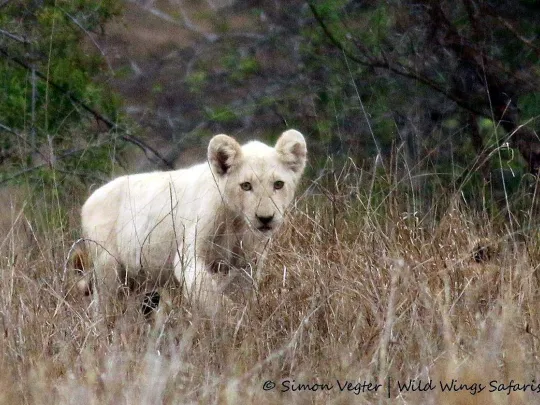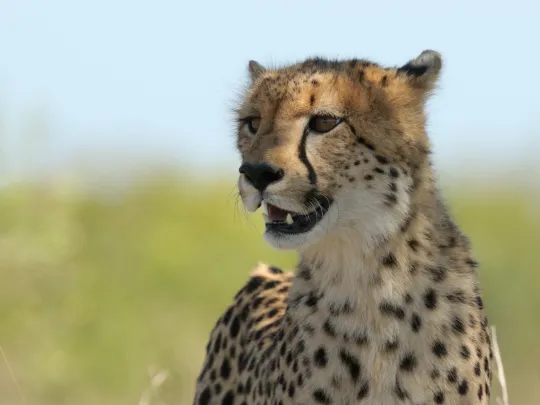A Rare Encounter with Africa's Most Elusive Big Cat
Deep in the heart of Laikipia, Kenya, a legendary creature moves like a shadow through a landscape of striking contrasts—from the low-lying land along the Ewaso Narok River, framed by rugged ridgelines and the fading traces of ancient dryland forests, to the vast plateaus in the west, where flat grassy plains meet the dramatic escarpments of the Great Rift Valley.
The Enigmatic Black Leopard of Laikipia
Known as Giza Mrembo, meaning "the beautiful darkness" in Swahili, this rare melanistic leopard has captured the imagination of wildlife enthusiasts worldwide. In May 2023, Wild Wings Safaris guide Simon Vegter embarked on a journey to Laikipia Wilderness Camp in search of Giza, hoping to witness and photograph one of Africa's most elusive big cats.
A Rare Safari Experience: Searching for Giza

© Simon Vegter
Spotting a leopard in the wild is always an extraordinary experience, but encountering a black leopard is something truly special. Black leopards, sometimes referred to as black panthers, are not a separate species but a melanistic variant of the African leopard (Panthera pardus).
The first confirmed sighting of a black leopard in Laikipia occurred in 2019, when photographer Will Burrard-Lucas captured stunning images of this near-mythical feline. Since then, Laikipia has emerged as one of the best places in the world to see black leopards in the wild.
While at least three melanistic leopards have been spotted in the area, the most famous—and most frequently seen—is Giza Mrembo. Born and raised less than a kilometre from Laikipia Wilderness Camp, Giza has captivated wildlife enthusiasts and photographers with her striking presence. Unlike many leopards that remain elusive, she is remarkably relaxed around safari vehicles, allowing for some of the most extraordinary black leopard sightings ever documented.
Visitors from around the world travel to Laikipia for the rare opportunity to catch a glimpse of Giza, a living testament to nature's genetic marvels.
What is Melanism?

© Simon Vegter
Melanism is a recessive genetic trait, meaning both parents must carry and pass on the gene for their offspring to display this rare condition. In black leopards, a specific mutation affects the gene responsible for coat colouration, leading to an overproduction of eumelanin—the pigment responsible for black colouration. Despite their dark appearance, the classic rosette pattern remains visible in certain lighting, revealing the leopard's signature markings beneath the inky coat.
Giza Mrembo, Laikipia's famous black leopard, inherited this trait from her parents. While her mother is a typical spotted leopard, her father is believed to be melanistic, meaning both carried the recessive gene necessary for Giza's striking black coat.
Giza's Story: Beauty, Resilience, and Survival

© Simon Vegter
Giza was first spotted as a young cub alongside her golden-coated mother during Kenya's devastating 2022 drought. With food scarce, she learned to adapt quickly, developing a unique hunting strategy. Unlike her spotted relatives, Giza couldn't rely on traditional leopard camouflage. Instead, she became an opportunistic predator, covering large distances and ambushing prey in open terrain.
Her life has been one of challenge and resilience. A dominant male leopard in the area frequently stole her kills, forcing Giza to become even more resourceful. She adapted by making multiple kills per night—one to satisfy her competitor and another to feed herself. This determination has solidified her reputation as a true survivor of the African wilderness.
Photographing the Ghost of Laikipia

© Simon Vegter
Wildlife photographers and safari-goers dream of capturing a black leopard on camera, but only a lucky few succeed. Simon Vegter's visit to Laikipia Wilderness Camp in May 2023 provided a rare opportunity to photograph Giza in her natural habitat. With patience and expert guiding, he managed to document this breathtaking feline as she navigated the rugged terrain.
Simon's images highlight not only Giza's rare beauty but also her strength and adaptability in an unforgiving environment. Each photograph serves as a testament to the importance of conservation efforts that protect these extraordinary creatures.
Where to See a Black Leopard in Kenya
For those eager to see Giza for themselves, Laikipia Wilderness Camp offers one of the best opportunities to track and observe this beautiful black leopard in her natural environment. This intimate safari camp, set in the heart of Laikipia, provides expert guiding, flexible game drives, and a high chance of spotting this elusive cat.
Tips for Seeing a Black Leopard in Laikipia
- Book a Black Leopard private safari guide and vehicle. Exclusive use of a vehicle ensures the best chance of tracking and photographing Giza.
- Stay multiple nights. Black leopard sightings are rare, so patience is key.
- Expect the unexpected. Laikipia is one of Africa's most diverse and rewarding safari destinations. While Giza sightings aren't guaranteed, the region offers incredible wildlife encounters, including one of Kenya's best chances to see the elusive African wild dog.
Respecting Giza's Space – Ethical Wildlife Viewing

© Simon Vegter
With the possibility of Giza introducing her cubs to the world, excitement is high. However, ethical wildlife viewing is essential to ensure these special moments unfold naturally, without human interference.
Responsible Viewing Guidelines
- Giza Leads – Sightings happen on her terms. No tracking or seeking out the cubs is attempted. As a naturally secretive mother, any pressure could cause her to move them to a more remote location.
- No Spotlights on Cubs Under Six Months – Artificial lighting is not used on the cubs at night. While spotlighting Giza remains at the guide's discretion, it is never done when she is with her young to avoid distress or attracting predators.
- Restricted Vehicle Movement – Once parked, vehicles remain stationary during sightings. If the cubs are on the move, vehicles don't intercept their path or block them, ensuring they develop a natural confidence in their environment.
- Respect Giza's Hunting & Feeding – If Giza has a kill, vehicles give her ample space. If she is seen carrying prey, she is left undisturbed to move freely. Any interference could cause her to abandon her meal or relocate her cubs.
By prioritising respectful, low-impact viewing, Giza and her cubs are protected while allowing future generations the chance to witness these rare and extraordinary sightings.
Conservation and the Future of Laikipia's Black Leopards

© Simon Vegter
The increasing visibility of black leopards in Laikipia is a testament to the success of conservation initiatives in the region. Through habitat protection and responsible tourism, these extraordinary big cats continue to thrive.
Giza's story is a reminder of nature's resilience and the delicate balance of the African wilderness. She is not just a rare photographic subject—she represents the untamed beauty and enduring spirit of Laikipia's leopards.
If you're ready to embark on a once-in-a-lifetime safari adventure to see the legendary black leopard of Laikipia, contact us today to start planning your journey.
You may also want to look at

The New White Lions of Kruger
Visitors to Kruger have been abuzz lately about the sightings of a rare white lion cub in the area surrounding Satara Restcamp. UPDATE: What the white lion looks like now.

Best Places To See Rhinos, Leopards, Cheetahs or Wild Dogs
What are the best destinations to see rhinos in Africa? What about some of the more elusive predators, such as leopards, cheetahs or wild dogs? These animal species are not equally common everywhere, and it helps to know where you might be most likely to see them.

Are White Rhinos Extinct?
Can I still see white rhinos in the wild? Following the sad news of the death of the last male northern white rhino in 2018, leaving only two females, the northern white rhino is now virtually extinct. Some tourists continue to express concern that they will no longer be able to see white rhinos in the wild.
About the author

Dianne Kokkonidis was born in Johannesburg, grew up in the Transkei and spent years exploring Europe. She returned to South Africa to live on a farm in the Outeniqua Mountains when the call of Africa got too loud to ignore. She comes from a family of storytellers, so it's no surprise she's now found her way into writing about one of the oldest stories known to mankind - the lure of Africa.


















